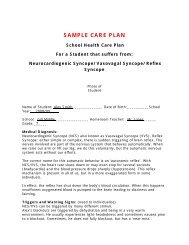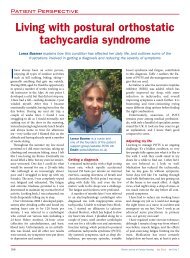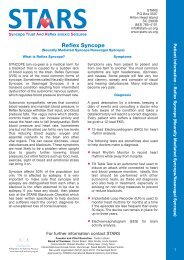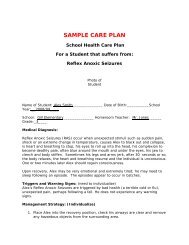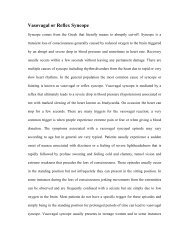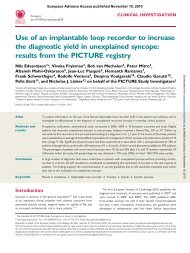New onset postural orthostatic tachycardia syndrome following ...
New onset postural orthostatic tachycardia syndrome following ...
New onset postural orthostatic tachycardia syndrome following ...
You also want an ePaper? Increase the reach of your titles
YUMPU automatically turns print PDFs into web optimized ePapers that Google loves.
J Interv Card ElectrophysiolDOI 10.1007/s10840-010-9506-4<strong>New</strong> <strong>onset</strong> <strong>postural</strong> <strong>orthostatic</strong> <strong>tachycardia</strong> <strong>syndrome</strong><strong>following</strong> ablation of AV node reentrant <strong>tachycardia</strong>Khalil Kanjwal & Beverly Karabin & Mujeeb Sheikh &Yousuf Kanjwal & Blair P. GrubbReceived: 5 May 2010 /Accepted: 24 June 2010# Springer Science+Business Media, LLC 2010AbstractBackground Autonomic dysfunction presenting as inappropriatesinus <strong>tachycardia</strong> has been reported to occur <strong>following</strong>slow pathway ablation for atrioventricular node <strong>tachycardia</strong>.We report on a series of patients who developed new <strong>onset</strong><strong>postural</strong> <strong>orthostatic</strong> <strong>tachycardia</strong> <strong>syndrome</strong> (POTS) <strong>following</strong>successful radiofrequency ablation of atrioventricular nodalreentrant <strong>tachycardia</strong> (AVNRT).Methods The study was a retrospective analysis that wasapproved by our Institutional Review Board. Patients wereidentified from those seen at our Syncope and AutonomicDisorders Clinic. A total of six patients were identified whowere previously healthy except for supraventricular <strong>tachycardia</strong>.Each was found to have AVNRT during electrophysiologystudy and each underwent successfulradiofrequency modification of the slow atrioventricularnodal pathway. Following ablation each patient developedthe new <strong>onset</strong> of symptoms of <strong>orthostatic</strong> intoleranceconsistent with POTS.Results After an initial symptom-free period (3–6 weeks) postablation each patient began to experience symptoms of<strong>orthostatic</strong> intolerance. All six patients began to experienceprogressive severe fatigue. Orthostatic <strong>tachycardia</strong> wasK. Kanjwal : B. Karabin : Y. Kanjwal : B. P. Grubb (*)Division of Cardiology, Department of Medicine,Health Sciences Campus,The University of Toledo Medical Center,Mail Stop 1118, 3000 Arlington ave,Toledo, OH 43614, USAe-mail: blair.grubb@utoledo.eduM. SheikhDivision of Internal Medicine, Department of Medicine,Health Sciences Campus,The University of Toledo Medical Center,Toledo, OH 43614, USAreported by five patients, syncope by three patients, andpresyncope by all six patients. Each patient reported theoccurrence of symptom while upright that were relieved bybecoming supine. Each patient had experienced symptoms forgreater than 6 months prior to being seen at our center. Threepatients reported such severe symptoms of <strong>orthostatic</strong><strong>tachycardia</strong> that they underwent repeat electrophysiologystudy; however, none had evidence of AVNRT. Each patientdemonstrated a POTS response within the first 10 min ofupright tilt with reproduction of their clinical symptoms thathad occurred post ablation.Conclusion POTS may be a complication of radiofrequencyablation of AVNRT.Keywords AV node reentrant <strong>tachycardia</strong> . Postural<strong>tachycardia</strong> <strong>syndrome</strong> . Radiofrequency ablation1 IntroductionRadiofrequency catheter ablation of a slow conductingpathway has become a standard modality for the treatmentof atrioventricular nodal reentrant <strong>tachycardia</strong> (AVNRT;[1–3]). There have been reports of inappropriate sinus<strong>tachycardia</strong> (IST) occurring as a complication of successfulradiofrequency catheter ablation of both, AVNRT [4–6] and<strong>following</strong> ablation of accessory atrioventricular reciprocating<strong>tachycardia</strong> pathways as well [7]. More recently, IST hasbeen reported to occur <strong>following</strong> cryoablation of AVNRT[8]. The mechanism by which this occurs is not wellunderstood nor has the frequency of this complication beenelaborated [8]. Here, we report on a series of patients whodeveloped new <strong>onset</strong> <strong>postural</strong> <strong>orthostatic</strong> <strong>tachycardia</strong><strong>syndrome</strong> (POTS) <strong>following</strong> successful radiofrequencyablation of AVNRT.
J Interv Card Electrophysiol2 MethodsThe study was a retrospective analysis that was approved byour Institutional Review Board. Patients were identified fromamong those referred to our Syncope and AutonomicDisorders Clinic. A total of six patients were identified whowere previously quite healthy except for supraventricular<strong>tachycardia</strong>. Each was found to have AVNRT during electrophysiologystudy and each underwent successful radiofrequencymodification of the slow AV nodal pathway. Followingablation each patient developed new <strong>onset</strong> symptoms of<strong>orthostatic</strong> intolerance consistent with POTS. Following radiofrequencyablation of each of these patients, six patientsdeveloped signs and symptoms of POTS. Each of thesepatients had their radiofrequency ablation performed at anoutside institution. Data was collected from patient interviews,physical examinations, and careful review of therecords of the procedures and other aspects of their medicalrecords. In addition to the aforementioned evaluations, eachpatient underwent a head-up tilt table test. While the tilt tabletesting protocol employed has been described elsewhere [9–11], briefly it consisted of a passive head upright tilt on atable with a foot board meant for weight bearing at an angleof 70° for a period of 30 min during which time heart rateand blood pressure were continuously monitored. All testswere performed after an overnight fast.We defined POTS as a chronic state of <strong>orthostatic</strong>intolerance and palpitations of greater than 6 months duration,associated with a reproducible heart rate increase of at least30 beats per minute (or a peak heart rate of 120 beats perminute or more) observed during the first 10 min of upright tilttable testing. The condition had to occur in the absence ofother chronic debilitating conditions. Commonly reportedsymptoms in patients suffering from POTS include exerciseintolerance, fatigue, palpitations, lightheadedness, cognitiveimpairment, syncope, and near syncope.Each of the ablative procedures was performed outsideour institution. Records showed that each patient underwenta standard electrophysiology study during which programmedelectrical stimulation induced typical AV nodal reentrant<strong>tachycardia</strong> (average rate 200 beats per minute) that matchedtheir clinical arrhythmias. Records also showed that anaverage of 6±4 radiofrequency applications were deliveredto the slow pathway with a power level of 40±10 watts eachfor a duration of 60 s. No complications were reported afterany of the procedures.3 ResultsSix patients, all women, aged (25±5), were identified forinclusion in the study. The clinical features of the group aresummarized in Table 1.Table 1 Baseline clinical characteristics of the study patients (N=6)Age 25±5Sex (Females) 6 (100%)Symptoms prior to ablationPalpitations 6 (100%)Symptoms of <strong>orthostatic</strong> intoleranceOrthostatic palpitations 5 (84%)Dizziness 5 (84%)Inability to concentrate 5 (84%)Syncope 3 (50%)Presyncope 6(100%)Fatigue 6 (100%)Chest pain 1 (16%)Comorbid conditionsHTN 1 (16%)Migraine 1 (16%)3.1 Symptoms of <strong>orthostatic</strong> intolerancePost ablation each patient reported a 3–6-week asymptomaticperiod. Following this each first patient began to experiencesymptoms of severe progressive fatigue. Shortly thereafter allsix patients reported having sensation of presyncope. Thesepatients reported having experienced full syncopal events andfive patients reported severe <strong>orthostatic</strong> <strong>tachycardia</strong>. Eachpatient reported the <strong>onset</strong> of symptoms while upright whichwere relieved by lying supine. Holter monitors wereperformed on each patient that showed sinus <strong>tachycardia</strong> ofrates averaging 120 beats per minute while upright whichreturned to normal levels (60–70 beats per minute) whilesupine. Each of the patients reported a progressive decline infunctional ability for a minimum of 6 months prior to referral.Three patients underwent repeat electrophysiological studies;however, none of these found evidence of recurrent AVNRT.Echocardiography was normal in all six patients, as weresupine resting electrocardiograms. All six patients were sodebilitated by their symptoms that they either lost theiremployment or had to discontinue educational pursuits.3.2 Responses to Head Up Tilt TestThe mean duration of symptoms prior to referral to ourcenter was 14±6 months. After a complete review of priorrecords, patients underwent a complete history and physicalexamination followed by HUTT. Each patient demonstrateda marked <strong>tachycardia</strong> response both during standing andduring HUTT. The mean heart rate increase (both withstanding and HUTT) was 43±10 beats per minute. All sixpatients reported that the symptoms provoked duringHUTT reproduced their clinical symptoms. No additionalautonomic testing was performed.
J Interv Card Electrophysiol3.3 TreatmentThe treatment protocols employed were based on ourprevious experiences with <strong>orthostatic</strong> disorders and aredescribed in detail elsewhere [9, 10, 12, 13]. Briefly, asequence of therapies was employed that included educationto avoid predisposing factors, an increase salt and fluidconsumption, physical counter maneuvers, and aerobic andresistance training. If these proved ineffective, pharmacotherapywas initiated in a sequence generally consisting ofbeta-blockers, central sympatholytics, fludrocortisone,midodrine, selective serotonin reuptake inhibitors, eitheralone or in combination. If the aforementioned agents wereineffective or poorly tolerated, second line agents likepyridostigmine, octreotide, and erythropoietin wereemployed.All six patients reported a significant reduction insymptoms and increase in functional status once asatisfactory treatment regimen has been elaborated. Thespecific symptoms, which improved the most in all sixpatients, were <strong>orthostatic</strong> palpitations and <strong>tachycardia</strong>,presyncope, and syncope. Three patients continued tocomplain of severe fatigue, which failed to respond to theaforementioned medications. These three patients laterreported significant improvement in their fatigue <strong>following</strong>treatment with Modafinil [14].4 DiscussionPOTS is a form of <strong>orthostatic</strong> intolerance associated with asignificant increase in heart rate while upright that resolveswith recumbency. POTS is perhaps better thought of as aphysiologic state (analogous to the state referred to as heartfailure) which can be brought on by a number of differentalterations in the body’s normal homeostatic mechanisms.As such POTS appears to be a heterogeneous group ofdisorders with similar clinical characteristics [15–19]. Onegroup of POTS patients appear to have an autoimmunebasis, with <strong>onset</strong> of symptoms <strong>following</strong> an acute febrileillness, associated with antibodies to the post-synapticacetylcholine receptors of the autonomic nerves [15].Another group has high circulating levels of norepinephrinethat occurs as a result of a genetic disturbance in thefunction of the norepinephrine reuptake proteins of adrenergicnerves. Yet another group appears to be in a chronicstate of “idiopathic hypovolemia” [20, 21]. In a recentlypublished study, it was reported that POTS might be amanifestation of autonomic cardiac neuropathy [22].However despite these observations there are manyPOTS patients where the etiology of their conditionremains unclear, resulting from pathophysiologies that haveyet to be elucidated. A number of different stressors havebeen observed to bring on symptoms of POTS. While manypatients describe an antecedent febrile illness (presumed tobe viral), there are also reports of pregnancy [23, 24],traumatic brain injury [25], electrocution [26], and lightninginjury [27], all appearing to cause <strong>onset</strong> of POTS.We report on a series of six patients who were quitehealthy except for episodic supraventricular <strong>tachycardia</strong>,who developed debilitating POTS after radiofrequencyablation of the slow AV nodal pathway. Review of theablation reports showed that they were uncomplicatedprocedures that eliminated their AVNRT. While it couldbe argued that the ablation and the <strong>onset</strong> of POTS wereunrelated, the temporal relationship between these events ina group of previously asymptomatic patients would suggestotherwise. The mechanism by which radiofrequency ablationcould result in POTS is unclear. Inappropriate sinus<strong>tachycardia</strong> has also been reported to occur after ablation[4–8]. Here it has been suggested that damage to the vagalfibers supplying the sinoatrial and AV nodal area occurs,resulting in a disruption of normal autonomic regulation.Similar mechanisms may be responsible for POTS postablation. Another potential explanation might involve aninflammatory stress caused by ablation that leads to ahyperadrenergic state and/or partial autonomic neuropathy.It is also possible that these patients had preexisting POTSthat was made worse by ablation; however, the completeabsence of symptoms prior to the procedure would makethis seem less likely.The frequency at which POTS may occur after ablationis unclear, and this group of patients represents only a smallpercentage of those referred to our institution each year.However this could principally reflect a lack of recognitionof the disorder. None of the six patients reported herein hadbeen referred by the physician that had performed theradiofrequency ablation itself (four were self referred andtwo were referred by their primary care physicians). Indeedin each case the physician who performed the ablationdismissed the patients’ complaints as being psychiatric innature and unrelated to the procedure itself. It is hoped thatthis report will provoke closer observation of patients whodevelop similar symptoms after ablative procedures, therebyfacilitating a better understanding of the frequency andpathogenesis of POTS post ablation while at the same timeproviding prompter diagnosis and management of thispotentially debilitating condition.5 ConclusionPOTS may occur as a complication of radiofrequencyablation of AVNRT. Recognition of the condition mayallow for better understanding of its incidence and causeand facilitate both diagnosis and management.
J Interv Card ElectrophysiolReferences1. Jackman, W. M., Beckman, K. J., McClelland, J. H., Wang, X.,Friday, K. J., Roman, C. A., et al. (1992). Treatment ofsupraventricular <strong>tachycardia</strong> due to atrioventricular nodal reentry,by radiofrequency catheter ablation of slow-pathway conduction.The <strong>New</strong> England Journal of Medicine, 327(5), 313–318.2. Lee, M. A., Morady, F., Kadish, A., Schamp, D. J., Chin, M. C.,Scheinman, M. M., et al. (1991). Catheter modification of theatrioventricular junction with radiofrequency energy for control ofatrioventricular nodal reentry <strong>tachycardia</strong>. Circulation, 83(3),827–835.3. Sousa, J., El-Atassi, R., Rosenheck, S., Calkins, H., Langberg, J., &Morady, F. (1991). Radiofrequency catheter ablation of the atrioventricularjunction from the left ventricle. Circulation, 84(2), 567–571.4. Ehlert, F. A., Goldberger, J. J., Brooks, R., Miller, S., & Kadish, A. H.(1992). Persistent inappropriate sinus <strong>tachycardia</strong> after radiofrequencycurrent catheter modification of the atrioventricular node. TheAmerican Journal of Cardiology, 69(12), 1092–1095.5. Capulzini, L., Sarkozy, A., Semeraro, O., Paparella, G., Chierchia,G. B., De Asmundis, C., et al. (2010). Ivabradine to treatinappropriate sinus <strong>tachycardia</strong> after the fast pathway ablation ina patient with severe pectus excavatum. Pacing Clin Electrophysiol,33, e32–35.6. Skeberis, V., Simonis, F., Tsakonas, K., Celiker, A., Andries, E.,& Brugada, P. (1994). Inappropriate sinus <strong>tachycardia</strong> <strong>following</strong>radiofrequency ablation of AV nodal <strong>tachycardia</strong>: incidence andclinical significance. Pacing and Clinical Electrophysiology, 17(5Pt 1), 924–927.7. Moreira, J. M., Curimbaba, J., Filho, H. C., & Pimenta, J. (2006).Persistent inappropriate sinus <strong>tachycardia</strong> after radiofrequencyablation of left lateral accessory pathway. Journal of CardiovascularElectrophysiology, 17(6), 678–681.8. De Sisti, A., Tonet, J., Benkaci, A., & Frank, R. (2010). A case ofinappropriate sinus <strong>tachycardia</strong> after atrio-ventricular nodalreentrant <strong>tachycardia</strong> cryoablation successfully treated by ivabradine.Europace, 12, 1029–1031.9. Grubb, B. P. (2005). Dysautonomic (<strong>orthostatic</strong>) syncope. In B. P.Grubb & B. Olshansky (Eds.), Syncope: Mechanisms andManagement (pp. 72–91). Malden, MA: Blackwell Publishing.10. Grubb, B. P. (2005). Neurocardiogenic Syncope. In B. P. Grubb &B. Olshansky (Eds.), Syncope: Mechanisms and Management (pp.47–71). Malden, MA: Blackwell Publishing.11. Raj, S. R. (2006). The Postural Tachycardia Syndrome (POTS):pathophysiology, diagnosis and management. Indian PacingElectrophysiol Journal, 6(2), 84–99.12. Grubb, B. P. (2008). Postural <strong>orthostatic</strong> <strong>tachycardia</strong>. Circulation,117, 2814–2817.13. Kanjwal, Y., Kosinski, D., & Grubb, B. P. (2003). The <strong>postural</strong><strong>orthostatic</strong> <strong>tachycardia</strong> <strong>syndrome</strong>: definitions, diagnosis, and management.Pacing and Clinical Electrophysiology, 26(8), 1747–1757.14. Kanjwal K, Saeed B, Karabin B, Kanjwal Y, Grubb BP.Preliminary Observations Suggesting That Treatment With ModafinilImproves Fatigue in Patients With Orthostatic Intolerance.Am J Ther. 2010 Apr 10. [Epub ahead of print]15. Jacob, G., Costa, F., Shannon, J. R., Robertson, R. M., Wathen,M., Stein, M., et al. (2000). The neuropathic <strong>postural</strong> <strong>tachycardia</strong><strong>syndrome</strong>. The <strong>New</strong> England Journal of Medicine, 343, 1008–1014.16. Rowe, P. C., Barron, D. F., Calkins, H., Maumenee, I. H., Tong, P.Y., & Geraghty, M. T. (1999). Orthostatic intolerance and chronicfatigue <strong>syndrome</strong> associated with Ehlers–Danlos <strong>syndrome</strong>.Jornal de Pediatria, 135, 494–499.17. Gazit, Y., Nahir, M., Grahame, R., & Jacob, G. (2003).Dysautonomia in the joint hypermobility <strong>syndrome</strong>. The AmericanJournal of Medicine, 115, 33–40.18. Jordan, J., Shannon, J. R., Diedrich, A., Black, B. K., &Robertson, D. (2002). Increased sympathetic activation in idiopathic<strong>orthostatic</strong> intolerance: role of systemic adrenoreceptorsensitivity. Hypertension, 39, 173–178.19. Shibao, C., Arzubiaga, C., Roberts, L. J., et al. (2005). Hyperadrenergic<strong>postural</strong> <strong>tachycardia</strong> <strong>syndrome</strong> in mast cell activationdisorders. Hypertension, 45, 385–390.20. Fouad, F. M., Tadena-Thome, L., Bravo, E. L., & Tarazi, R. C.(1986). Idiopathic hypovolumia. Annals of Internal Medicine, 104(3), 298–303.21. Rosen, S. G., & Cryer, P. E. (1982). Postural <strong>tachycardia</strong><strong>syndrome</strong>. Reversal of sympathetic hyperresponsiveness andclinical improvement during sodium loading. The AmericanJournal of Medicine, 72(5), 847–850.22. Haensch, C. A., Lerch, H., Schlemmer, H., Jigalin, A., &Isenmann, S. (2010). Cardiac neurotransmission imaging with123I-meta-iodobenzylguanidine in <strong>postural</strong> <strong>tachycardia</strong> <strong>syndrome</strong>.Journal of Neurology, Neurosurgery and Psychiatry, 81(3), 339–343.23. Kanjwal, K., Karabin, B., Kanjwal, Y., & Grubb, B. P. (2009).Postpartum <strong>postural</strong> <strong>orthostatic</strong> <strong>tachycardia</strong> <strong>syndrome</strong> in a patientwith the joint hypermobility <strong>syndrome</strong>. Cardiol Res Pract, 2009,187543.24. Kanjwal, K., Karabin, B., Kanjwal, Y., & Grubb, B. P. (2009).Outcomes of pregnancy in patients with preexisting <strong>postural</strong><strong>tachycardia</strong> <strong>syndrome</strong>. Pacing and Clinical Electrophysiology, 32(8), 1000–1003.25. Kanjwal K, Karabin B, Kanjwal Y, Grubb BP. Autonomicdysfunction presenting as Postural <strong>tachycardia</strong> <strong>syndrome</strong> <strong>following</strong>traumatic brain injury. Cardiology Journal, 17. April 30, 2010[Epub ahead of print]26. Kanjwal K, Karabin B, Kanjwal Y, Grubb BP. (2010). PosturalOrthostatic Tachycardia Syndrome: A Rare Complication FollowingElectrical Injury. Pacing Clin Electrophysiol, 33, e59–e6127. Grubb, B. P., & Karabin, B. (2007). <strong>New</strong> <strong>onset</strong> <strong>postural</strong><strong>tachycardia</strong> <strong>syndrome</strong> <strong>following</strong> lightning injury. Pacing andClinical Electrophysiology, 30(8), 1036–1038.



